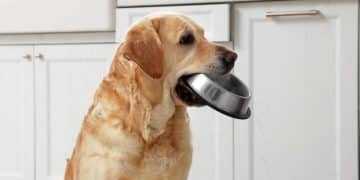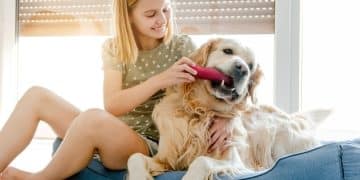Stop Food Guarding: A Comprehensive Resource Aggression Training Guide
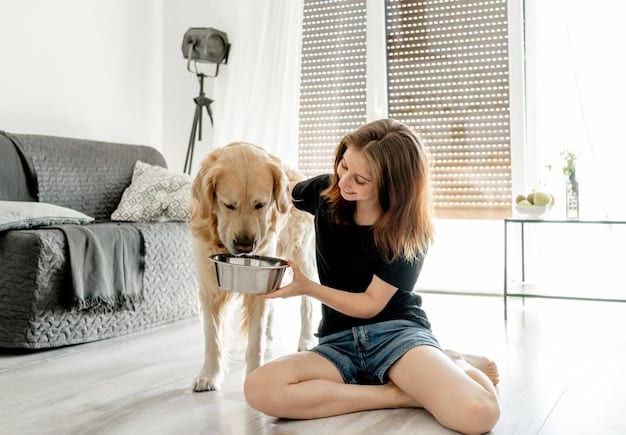
Stop food guarding involves resource aggression training techniques that teach dogs to feel secure, rather than threatened, when people or other animals approach their food, reducing the likelihood of possessive and aggressive behaviors.
Is your dog growling or snapping when you get near their food bowl? This is known as food guarding, a form of resource aggression. Let’s explore stop food guarding: a practical guide to resource aggression training, turning stressful mealtimes into peaceful, positive experiences.
Understanding Food Guarding in Dogs
Food guarding, or resource guarding, is a common behavioral issue in dogs where they protect their food from perceived threats. Understanding why dogs exhibit this behavior is the first step in addressing it with effective training techniques.
Why Dogs Guard Their Food
Dogs may guard their food due to instinct, past experiences, or perceived resource scarcity. In a multi-dog household, competition can exacerbate this behavior.
- Instinct: Ancestral dogs had to compete for food.
- Past experiences: Negative experiences, like having food taken away, can trigger guarding.
- Resource scarcity: Dogs may worry about not getting enough food.
Recognizing the Signs of Food Guarding
Early detection of food guarding can prevent escalation. Signs can range from subtle to aggressive, and understanding these indicators is key.
Watch out for signs such as:
- Tensing up while eating.
- Eating faster when someone approaches.
- Growling or snapping.
- Showing teeth or lunging.
Food guarding is a natural behavior rooted in a dog’s instinct to protect valuable resources. By understanding the underlying causes and recognizing the warning signs, dog owners can implement effective training techniques to mitigate the behavior, creating a safer and more peaceful environment for everyone.
Assessing Your Dog’s Food Guarding Severity
Before starting any training, it’s crucial to assess the severity of your dog’s food guarding. This assessment will help tailor the training approach to your dog’s specific needs and behavior.
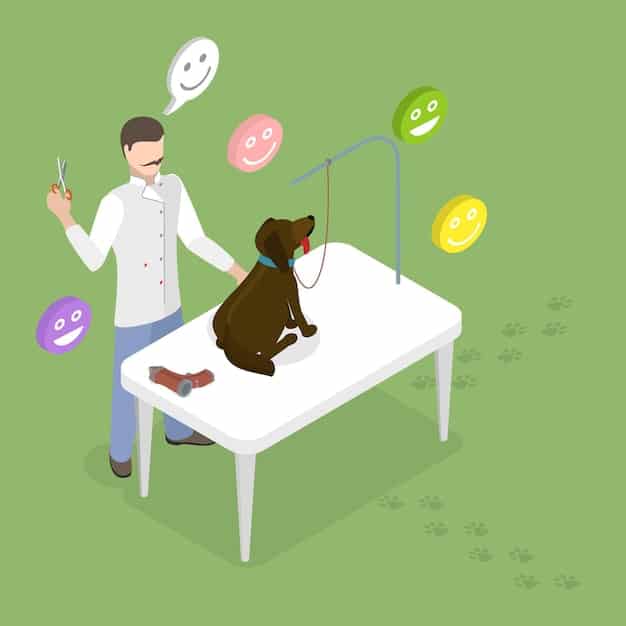
Mild Food Guarding
Dogs exhibiting mild food guarding may show subtle signs like tensing up or eating faster. These dogs are typically easier to train.
Mild signs include:
- Stiffening of body posture when approached.
- Eating more rapidly.
- Giving a hard stare without further aggression.
Severe Food Guarding
Severe food guarding involves overt aggression, such as growling, snapping, or biting. These cases require careful, professional intervention.
Severe signs include:
- Growling or snarling even with a slight approach.
- Snapping or lunging.
- Biting.
Assessing the severity of food guarding is crucial for determining the appropriate training strategy. Mild cases can often be managed with positive reinforcement and gradual desensitization, while severe cases may require the expertise of a professional dog trainer or behaviorist to ensure safety and effectiveness.
Creating a Safe Training Environment
A safe and controlled environment is essential for successful resource aggression training. Both you and your dog need to feel secure to effectively work through the training process.
Here are key steps to ensure safety:
- Choose a Quiet Space: Set up training in a calm, distraction-free area.
- Use a Leash: Keep your dog on a leash to maintain control, especially in the initial stages.
- Avoid Direct Confrontation: Never punish or physically confront your dog for guarding.
It is also important to ensure your safety. If your dog has a history of severe aggression, consult a professional dog trainer or behaviorist before attempting any training on your own.
Positive Reinforcement Techniques
Positive reinforcement is the cornerstone of effective food guarding training. Rewarding your dog for calm behavior around food helps change their association with your presence.
There are several specific techniques:
- Hand Feeding: Start by hand-feeding small portions of your dog’s meal to build trust.
- Adding to the Bowl: Approach the bowl while your dog is eating and drop high-value treats in.
- Trading Up: Offer a more desirable treat in exchange for the food in the bowl.
Hand Feeding
Hand feeding fosters trust and teaches your dog that your presence is positive. It also helps establish you as the provider of good things.
Adding to the Bowl
This technique teaches your dog that your approach results in more food, not less. Always add something highly appealing to increase the positive association.
Positive reinforcement techniques are effective because they focus on building a positive association between your presence and your dog’s food. By consistently rewarding calm behavior, you can gradually change your dog’s perception of your approach, reducing the anxiety that leads to food guarding.
Desensitization and Counterconditioning
Desensitization and counterconditioning are powerful methods to change your dog’s emotional response to your approach during mealtimes. These techniques involve gradually exposing your dog to your presence while associating it with positive experiences.
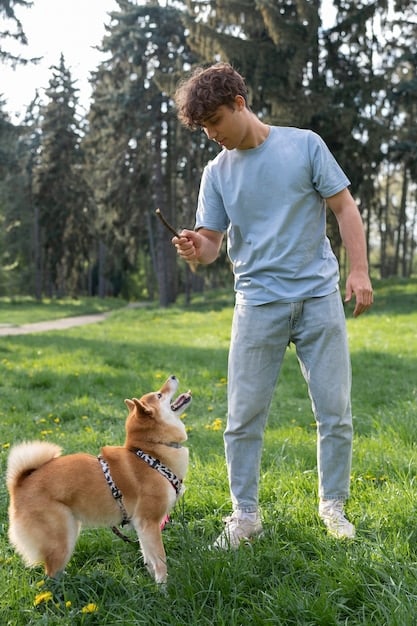
Desensitization
Desensitization involves gradually exposing your dog to your presence at a distance. Start far enough away that your dog doesn’t react, then slowly decrease the distance over time.
Counterconditioning
Counterconditioning changes your dog’s association with your approach from negative to positive. By pairing your presence with high-value treats, you create a positive emotional response.
This involves:
- Starting at a Distance: Begin far enough away that your dog is comfortable.
- Pairing with Treats: Each time you approach, toss a treat toward your dog.
- Gradual Progression: Slowly decrease the distance as your dog becomes more comfortable.
Desensitization and counterconditioning work together to change your dog’s emotional response to your presence during mealtimes. By gradually exposing your dog to your approach and pairing it with positive experiences, you can reduce their anxiety and defensive behavior, transforming mealtimes into more peaceful interactions.
Managing a Multi-Dog Household
In multi-dog households, food guarding can be more complex due to competition. Managing feeding times and locations is crucial to prevent conflicts.
Separate Feeding Areas
Feed each dog in a separate area to minimize competition. This can be in different rooms or at opposite ends of the same room.
Supervised Feeding Times
Always supervise feeding times to ensure that one dog does not approach another’s food. Pick up bowls as soon as they are finished eating.
Seeking Professional Help
If food guarding escalates or if you’re uncomfortable managing the behavior yourself, seek professional help from a certified dog trainer or behaviorist. They can provide tailored guidance and ensure the safety of everyone involved.
| Key Point | Brief Description |
|---|---|
| 🛡️ Understanding Food Guarding | Recognize causes & signs to start effective training. |
| 📈 Assessing Severity | Determine if it’s mild (tensing) or severe (aggression). |
| 🍎 Positive Reinforcement | Use treats when approaching to create a positive association. |
| 🐕🦺 Multi-Dog Management | Feed dogs separately and supervise meal times to avoid conflict. |
Frequently Asked Questions
▼
Food guarding is often rooted in a dog’s instinct to protect resources, potentially amplified by scarcity or negative past experiences.
▼
Early signs include tensing of the body, eating faster, staring intently, and reluctance to move away from the food.
▼
Start by approaching from a distance, tossing treats towards the bowl, and gradually decreasing the distance as they remain calm.
▼
Stop immediately, increase the distance, and consult a professional trainer to assess and manage the aggression safely and effectively.
▼
Training time varies depending on the severity of the guarding and the dog’s responsiveness, but consistency and patience are key for success.
Conclusion
Overcoming food guarding requires patience, consistency, and a positive approach. By understanding the reasons behind this behavior and implementing appropriate training techniques, you can transform stressful mealtimes into peaceful interactions, enhancing the bond with your dog.
